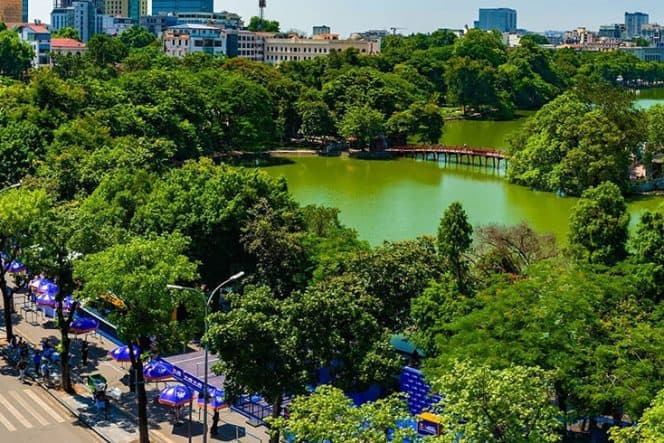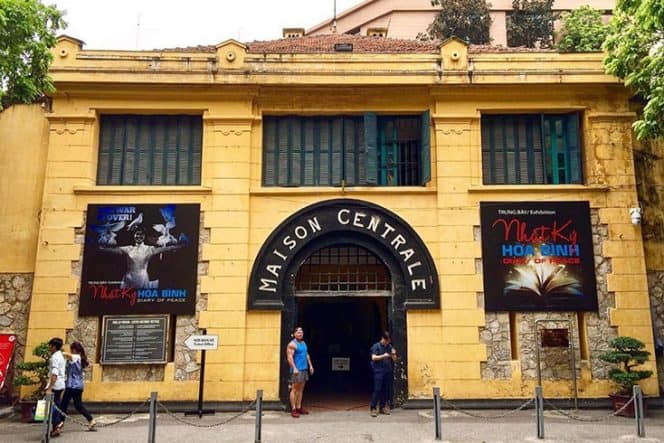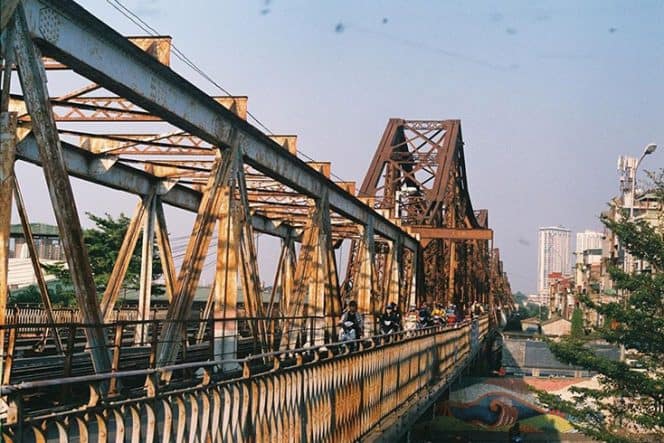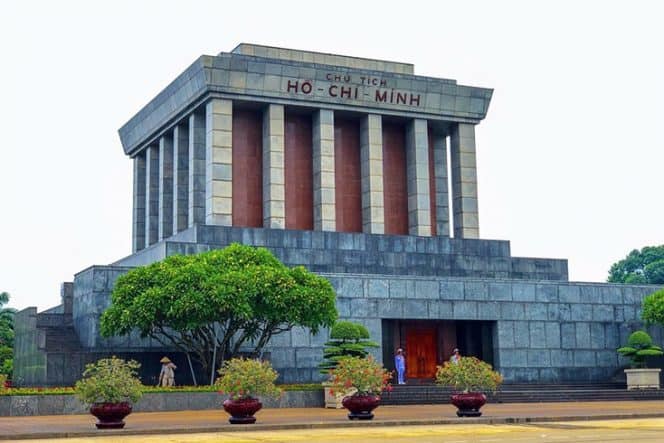10 Best Things to Do in Hanoi, Vietnam
Hanoi is over 1000 years old. Over these years, the city underwent ups and downs in its history, so the richness of history here is overwhelming: ancient architectural structures, temples, pagodas, etc. So great is it that you will be fun-filled to explore the capital of Vietnam all day.
Want to explore natural and historical attractions in Hanoi, which are famous for its both modern and ancient beauty? Put our guide into your pocket to know the best thing to do in Hanoi, including about what to see and where to visit in the capital of Vietnam!

Hoan Kiem Lake, the heart of the capital, is one of the most popular historical attractions in Hanoi for tourists. Owing to being located in the center of Hanoi, near almost other renowned destinations such as Ngoc Son Temple, The Huc Bridge, Turtle Tower, Hanoi Opera House, etc., Hoan Kiem Lake becomes so famous that whenever you mention Hanoi, tourists will associate immediately with its image.
Not only does Hoan Kiem Lake have cultural value but it also has a historical one. There is a well-known legend relating to the origin of the name of this lake. A long time ago, this lake was called Luc Thuy lake because its color water was green in all seasons. The name “Hoan Kiem Lake” or “Ho Guom” just appeared from the beginning of the 15th century and attached with the legend that Ly Thai To, the first king of the Hau Le dynasty, returned the magical sword to the Golden Turtle on this lake.
Walking around the lake, one of the best things to do in Hanoi, tourists can take a view of the contrasting beauty of an old Hanoi with classical architecture features on ancient structures around here, a new Hanoi with the fast lifestyle and a lot of luxury modern restaurants and hotels built in Western-style. Besides, since 2017, every weekend, there is walking street opening around the lake attracting tourists with a lot of outdoor activities and Vietnamese street food.
Not only does Hoan Kiem Lake have cultural value but it also has a historical one. There is a well-known legend relating to the origin of the name of this lake. A long time ago, this lake was called Luc Thuy lake because its color water was green in all seasons. The name “Hoan Kiem Lake” or “Ho Guom” just appeared from the beginning of the 15th century and attached with the legend that Ly Thai To, the first king of the Hau Le dynasty, returned the magical sword to the Golden Turtle on this lake.
Walking around the lake, one of the best things to do in Hanoi, tourists can take a view of the contrasting beauty of an old Hanoi with classical architecture features on ancient structures around here, a new Hanoi with the fast lifestyle and a lot of luxury modern restaurants and hotels built in Western-style. Besides, since 2017, every weekend, there is walking street opening around the lake attracting tourists with a lot of outdoor activities and Vietnamese street food.
Location: Hoan Kiem District, Hanoi
Opening hours: 19:00 AM, Friday – 24:00 AM, Sunday
Opening hours: 19:00 AM, Friday – 24:00 AM, Sunday
Hoa Lo Prison is among the most famous historicalattractions in Hanoi, where tourists cannot miss if they are history lovers. Hoa Lo Prison or Mai Son Centrale is a clear proof of the war crime French colonialism caused to the Vietnamese.
At the end of the 19th century, in 1896, the French colonialists built Hoa Lo Prison in Phu Khanh village, Hanoi. It was one of the largest and most modern prisons of the French colonialist in Indo-Chinese, used to detain and torture Vietnamese patriotic soldiers. After the war, it is opened again to use as a well-known historical museum.
Paying a visit to Hoa Lo Prison, tourists will see many statues recreating the hard life in political prisons, the small wet and dirty cells detaining a lot of prisoners, the machines and hundred cruel methods to torturing. At that time, Hoa Lo Prison was also renowned for its harshest punishment, called “the hell of the earth” or the most inhumane prison in Indo-Chinese.
At the end of the 19th century, in 1896, the French colonialists built Hoa Lo Prison in Phu Khanh village, Hanoi. It was one of the largest and most modern prisons of the French colonialist in Indo-Chinese, used to detain and torture Vietnamese patriotic soldiers. After the war, it is opened again to use as a well-known historical museum.
Paying a visit to Hoa Lo Prison, tourists will see many statues recreating the hard life in political prisons, the small wet and dirty cells detaining a lot of prisoners, the machines and hundred cruel methods to torturing. At that time, Hoa Lo Prison was also renowned for its harshest punishment, called “the hell of the earth” or the most inhumane prison in Indo-Chinese.
Location: 1 Hoa Lo, Tran Hung Dao, Hoan Kiem, Hanoi
Opening hours: Everyday from 8:00 AM – 5:00 PM
Ticket Price: 30.000VND/Adult (Discount 50% for student with the car)
Phone: 024 3934 2253
Opening hours: Everyday from 8:00 AM – 5:00 PM
Ticket Price: 30.000VND/Adult (Discount 50% for student with the car)
Phone: 024 3934 2253


Going to the so-called first university of Hanoi is among the best things to do in Hanoi. Temple of Literature is a cultural and educational heritage of Vietnam and often cited as one of the most attractive historical Hanoi attractionsfor both the foreign and the Vietnamese.
It is a combination of two architectural complexes: Van Mieu, a confucian temple, the worship place of Khong Tu, Manh Tu and Chu Van An, and Quoc Tu Giam, the first university in Vietnam. Temple of Literature is surrounded by stone walls and there are a lot of old trees on campus; therefore, it is always peaceful although today it is located on one of the most crowded streets.
Originally, King Ly Thanh Tong only built Van Mieu for the purpose of worshipping; besides, it was also used as the royal school at that time. In 1076, Van Mieu was enlarged with the construction of Quoc Tu Giam by King Ly Nhan Tong, the son of King Ly Thanh Tong in order to teach the royal. Until 1253, Quoc Tu Giam changed Quoc Tu Giam into the National Academy even for children of civilians who had excellent learning ability.
Paying a visit to the Temple of Literature, tourists will see the buildings preserved extremely well, a superb instance of traditional Vietnamese architecture, stone turtles on which the names of the doctors in the Ly and Tran dynasty. This is really an educational and rewarding thing to do in Hanoi.
It is a combination of two architectural complexes: Van Mieu, a confucian temple, the worship place of Khong Tu, Manh Tu and Chu Van An, and Quoc Tu Giam, the first university in Vietnam. Temple of Literature is surrounded by stone walls and there are a lot of old trees on campus; therefore, it is always peaceful although today it is located on one of the most crowded streets.
Originally, King Ly Thanh Tong only built Van Mieu for the purpose of worshipping; besides, it was also used as the royal school at that time. In 1076, Van Mieu was enlarged with the construction of Quoc Tu Giam by King Ly Nhan Tong, the son of King Ly Thanh Tong in order to teach the royal. Until 1253, Quoc Tu Giam changed Quoc Tu Giam into the National Academy even for children of civilians who had excellent learning ability.
Paying a visit to the Temple of Literature, tourists will see the buildings preserved extremely well, a superb instance of traditional Vietnamese architecture, stone turtles on which the names of the doctors in the Ly and Tran dynasty. This is really an educational and rewarding thing to do in Hanoi.
Location: 58 Quoc Tu Giam, Van Mieu, Dong Da, Hanoi
Opening hours:
Summer (15/4 – 15/10): 07:30 AM – 18:00 AM
Winter: 08:00 AM – 17:00 AM
Ticket Price: 30.000VND/Adult (Discount 50% for the disabled, students from the age of 15 and free for children under 15 years old and the especially disabled)
Phone: 024 3747 2566
Opening hours:
Summer (15/4 – 15/10): 07:30 AM – 18:00 AM
Winter: 08:00 AM – 17:00 AM
Ticket Price: 30.000VND/Adult (Discount 50% for the disabled, students from the age of 15 and free for children under 15 years old and the especially disabled)
Phone: 024 3747 2566

Long Bien Bridge
For people living in Hanoi, Long Bien Bridge is a historical witness of a resilient Hanoi in years of war. Nowadays, it has become a destination in Hanoi that is very popular among foreign tourists.
Long Bien Bridge is an iron bridge across the Red River connecting the suburb of Hanoi with the center of the city. It was constructed from 1899 to 1902 by French colonists and designed by a famous French engineer Gustave Eiffel, the father of the Eiffel Tower in Paris. At that time, it is the most modern bridge in Indo-Chinese, the pride of French architecture. After two fierce wars in Vietnam, especially relentless American bombing in 1972, Long Bien Bridge was not damaged, still the artery of Hanoi during the war.
Nowadays, there are some other bridges built across the Red River, so there is not a lot of traffic on the bridge and tourists can walk along it to go sightseeing. From Long Bien Bridge, tourists can take a view of the picturesque sceneries, large green fruit field, small houses near the bank of the Red River.
After a long time, although Long Bien Bridge is broken somehow, its beauty is still intact in the eyes of Vietnamese people and foreigners. It is worth spending an afternoon on paying a visit to this attraction.
Long Bien Bridge is an iron bridge across the Red River connecting the suburb of Hanoi with the center of the city. It was constructed from 1899 to 1902 by French colonists and designed by a famous French engineer Gustave Eiffel, the father of the Eiffel Tower in Paris. At that time, it is the most modern bridge in Indo-Chinese, the pride of French architecture. After two fierce wars in Vietnam, especially relentless American bombing in 1972, Long Bien Bridge was not damaged, still the artery of Hanoi during the war.
Nowadays, there are some other bridges built across the Red River, so there is not a lot of traffic on the bridge and tourists can walk along it to go sightseeing. From Long Bien Bridge, tourists can take a view of the picturesque sceneries, large green fruit field, small houses near the bank of the Red River.
After a long time, although Long Bien Bridge is broken somehow, its beauty is still intact in the eyes of Vietnamese people and foreigners. It is worth spending an afternoon on paying a visit to this attraction.
Location: Ngoc Thuy, Long Bien, Hanoi

5.St.Josept Cathedral
St Joseph Cathedral, or “The Big Church” familiarly called by the locals, is one of the few famous structures constructed by French colonists and still intact in Hanoi after two fierce wars.
The construction of this structure took place from 1884 to 1887 on the site of Bao Thien pagoda near Hoan Kiem Lake, the most ancient magnificent and massive one, the center of Buddhism in the history of Vietnam. St Joseph Cathedral was a small simulation of Notre Dame de Paris with multiple representative features of Gothic Revival architecture.
During the French colonial period, St Joseph Cathedral became the center of Christianity in North Vietnam. After the retreat of French colonists from the North of Vietnam in 1954, the cathedral was closed and not until Christmas in 1990, was it opened again for the Catholics to celebrate.
In spite of fierce fights destroying almost parts of Hanoi, St Joseph Cathedral is still in good condition. Today, it becomes a historicalattraction in Hanoi which always makes an impression on travelers by its ancient beauty inside the bustling capital.
The construction of this structure took place from 1884 to 1887 on the site of Bao Thien pagoda near Hoan Kiem Lake, the most ancient magnificent and massive one, the center of Buddhism in the history of Vietnam. St Joseph Cathedral was a small simulation of Notre Dame de Paris with multiple representative features of Gothic Revival architecture.
During the French colonial period, St Joseph Cathedral became the center of Christianity in North Vietnam. After the retreat of French colonists from the North of Vietnam in 1954, the cathedral was closed and not until Christmas in 1990, was it opened again for the Catholics to celebrate.
In spite of fierce fights destroying almost parts of Hanoi, St Joseph Cathedral is still in good condition. Today, it becomes a historicalattraction in Hanoi which always makes an impression on travelers by its ancient beauty inside the bustling capital.
Location: 40 Nha Chung, Hang Trong ward, Hoan Kiem district, Hanoi
Opening hours:
For visiting outside: All time
For visiting inside: Travellers can only visit inside when there is ceremonial practice as the below schedule
Weekday: 5:30 am and 6:15 pm
Saturday: 6:00 pm
Sunday: 5:00 am, 7:00 am, 9:00 am, 11:00 am, 4:00 pm, 6:00 pm and 8:00 pm
A special ceremony is on 19th March every year.
Phone: 024 3828 5967
Entrance fee: free
Opening hours:
For visiting outside: All time
For visiting inside: Travellers can only visit inside when there is ceremonial practice as the below schedule
Weekday: 5:30 am and 6:15 pm
Saturday: 6:00 pm
Sunday: 5:00 am, 7:00 am, 9:00 am, 11:00 am, 4:00 pm, 6:00 pm and 8:00 pm
A special ceremony is on 19th March every year.
Phone: 024 3828 5967
Entrance fee: free
6. Ho Chi Minh’s Mausoleum is considered the heart of the capital, expressing the sincere gratitude and love of Vietnamese people to President Ho Chi Minh. It is the last resting place of Uncle Ho, the mighty hero, the loved old father of the Vietnamese, who led the national liberation struggle movement in Vietnam to defeat French colonists and American empire in the twentieth century.
Uncle Ho passed away on September 2nd, 1969 in Hanoi, but it was not until September 2nd, 1973 that the construction of this mausoleum proceeded. It took about two years to complete this structure. Ho Chi Minh’s Mausoleum was inaugurated on August 29th, 1975, and since then, it has become a well-known historical tourist site in Hanoi not only for the Vietnamese but also for the foreign.
Vietnamese architects at that time took inspiration from Lenin’s Mausoleum in Moscow to design Ho Chi Minh’s Mausoleum. It was built on Ba Dinh square, where Uncle Ho had read the Declaration of Independence on September 2nd, 1945, giving birth to the Democratic Republic of Vietnam in the presence of the Vietnamese, many international journalists, international friends, and French colonists.
Nowadays, tourists can pay a visit to Ho Chi Minh’s Mausoleum at any time in a year. When coming here, pay attention to your address, avoid wearing too short clothes and under three-year-old children are not allowed to enter here.
Uncle Ho passed away on September 2nd, 1969 in Hanoi, but it was not until September 2nd, 1973 that the construction of this mausoleum proceeded. It took about two years to complete this structure. Ho Chi Minh’s Mausoleum was inaugurated on August 29th, 1975, and since then, it has become a well-known historical tourist site in Hanoi not only for the Vietnamese but also for the foreign.
Vietnamese architects at that time took inspiration from Lenin’s Mausoleum in Moscow to design Ho Chi Minh’s Mausoleum. It was built on Ba Dinh square, where Uncle Ho had read the Declaration of Independence on September 2nd, 1945, giving birth to the Democratic Republic of Vietnam in the presence of the Vietnamese, many international journalists, international friends, and French colonists.
Nowadays, tourists can pay a visit to Ho Chi Minh’s Mausoleum at any time in a year. When coming here, pay attention to your address, avoid wearing too short clothes and under three-year-old children are not allowed to enter here.
Location: 19 Ngoc Ha Street, Ba Dinh District, Ha Noi
Opening hours:
In summer (from 01/04 to 31/10): Tuesday and Thursday: from 07:30 am to 10:30 am; Saturday, Sunday and Holiday: from 07:30 am to 11:00 am.
In winter (from 01/11 to 31/03): Tuesday and Thursday: from 08:00 am to 11:00 am; Saturday, Sunday and Holiday: from 08:00 am to 11:30 am.
Entrance fee: Free
Phone: 04 38455168, 0437345484
Note: If May 19th, September 2rd and the first day of the Lunar New Year coincide with the closing days, it will still be opened to hold the ceremony.
Opening hours:
In summer (from 01/04 to 31/10): Tuesday and Thursday: from 07:30 am to 10:30 am; Saturday, Sunday and Holiday: from 07:30 am to 11:00 am.
In winter (from 01/11 to 31/03): Tuesday and Thursday: from 08:00 am to 11:00 am; Saturday, Sunday and Holiday: from 08:00 am to 11:30 am.
Entrance fee: Free
Phone: 04 38455168, 0437345484
Note: If May 19th, September 2rd and the first day of the Lunar New Year coincide with the closing days, it will still be opened to hold the ceremony.

Leave a Reply